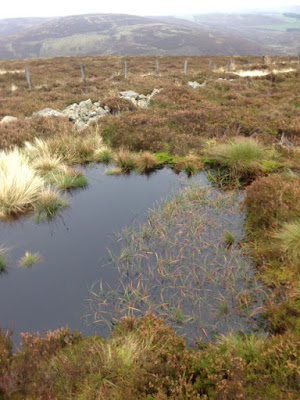A beguiling gloom
‘A beguiling gloom’
14th October 2017
By mid-October the shooting
season is well underway, attracting a large number of visitors to the area to partake
in the dubious pleasure of blasting away at a range of feathered creatures. By
accident we stumble across what we assume is a sort of open air game bird
factory on our weekly perambulations around the Border countryside. Another
overcast and gloomy morning but with a forecast of thinning cloud and some
sunshine by lunchtime. Destination today is Seathope Law, sitting back from the
A72, at a height of 542 metres; it sits close to the small hamlet of
Clovernfords. We park next to a collection of houses scattered within the precincts
of Holylee farm. Beyond the farm yard the track passes a well-built cairn
marking a ‘holy well’ and a small damned up section of water, before striking
uphill and away from Perlooie burn,
gurgling its way downhill to the Tweed river in the valley below. It is
here we begin to experience the ‘pheasant farm’, for they are the dominant
bird. These are a normal feature of the Border countryside and are usually encountered
without comment. But here is different. They constantly and in great numbers
explode from behind dykes, from the cover of bracken or the protection of
heather. They zoom across our path, cackling loudly as they first rise, then
soar, and then drop again a few hundred metres away. Not meant for long flight
from what I can see, and bred to stay close to their home, each voyage lasts about the same distance before
they return to ground and dive for cover. As we gain height their numbers seems
to increase, I count nine in the corner of a small field. After a while the
swoosh and accompanying cackle from each take off, begins to irritate and
distract. Finally, as we reach the path that takes us onto the lower slope of
Stony Knowe, we are freed from their presence. The steep early section sees us
gasping for breath and me wondering what drags us from the comfort of our homes
each week. However, walks are ever changing and once we have broken sweat and
reached the higher ground the going becomes easier and the walking more
enjoyable. The height we have now gained exposes a deep and stretched view of
the valley floor, opening out as it traces its way west to Peebles and beyond.
We follow the path up through thick heather, and onto open moorland. The stone
dyke that runs alongside has a well-built lower section, topped by larger
looser fitting boulders with regular cross stones holding it all in place.
Unusual and fragile looking, given the covering of moss and lichen it has
clearly survived intact for a long time. As we finally reach the crest of
Seathope Law rain sweeps in. We berate the BBC forecast which had promised
breaking cloud and sunshine by the middle of the day. The views however, help
distract from the deluge. Beyond the surrounding valleys lines of hills
dominate the landscape. The rain and low cloud producing a bleak and
melancholic atmosphere as the sky drops and merges and enfolds the land. On the descent we lose the path and plunge
through fields of deep heather, submerged up to our knees, each step taken with
care as dips and hollows threaten damaged flesh or broken bones. Below a track
winds between hills leading back to the starting farm yard. By now the rain has
stopped but the remaining straggles of cloud still sit within the creases and pleats
of the hills. Again the effect is bewitching, as the scene changes and shifts
as the rain clouds withdraw. Lining each side of the valley below are identical
shaped blocks of conifers, their serried ranks resembling formations of troops.
It brings to mind Alastair Moffatts recounting of the well organised echelons of
Roman troops entering the Border valleys in AD79*, designed to impress and
threaten the local Votadini tribe. Finding the track we return to the world of
the pheasant, this time in even greater numbers, but also joined by grouse and
partridge. This upper valley roadway seems to be a sort of open firing range. Every few yards
orange boxes are posted for the depositing of empty cartridges and the number
of game birds propelling themselves upwards appear in much greater
concentrations to what we encountered earlier in the walk. They now appear in
small flocks advancing before us as we tramp our way along the rough track.
Firing anywhere would seem to guarantee a hit. Finally we drop back into the
farmyard and locate the car. The day remembered for the high desolate hills,
shrouded in a beguiling gloom, and the sort of madness of these gamebirds
everywhere bursting and screeching their way into the damp and enveloping murk.
*Moffat A. (2007) The Borders: A history of the Borders from
earliest times. Edinburgh:Birlinn


Comments
Post a Comment